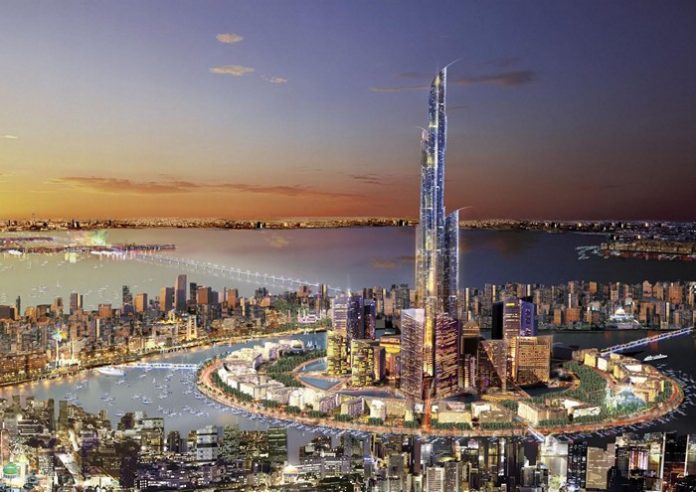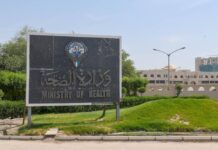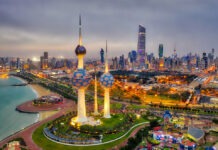Kuwait is committed to realizing the vision of His Highness the Amir Sheikh Sabah Al-Ahmad Al-Jaber Al-Sabah to transform Kuwait into an international trade and financial hub and to achieve Kuwait’s vision of New Kuwait 2035. Central to this strategic plan is the development of Silk City, or Madinat Al-Hareer as it is known in Arabic, which will be the largest marine front project in the world, and the Mubarak Al-Kabeer Port that are designed to bring Kuwait on the world map of tourism, commerce and investment.
First phase in the development of Silk City located in Subiya area across Kuwait Bay in northern Kuwait, and in the five Kuwaiti islands lying off the Kuwait coastline, was inked in mid-February during a visit to Kuwait by a high level Chinese delegation headed by Vice Chairman of the National Development and Reform Commission of the People’s Republic of China, Ning Jizhe.
The delegation met with His Highness the Amir Sheikh Sabah Al-Ahmad Al-Jaber Al-Sabah, Speaker of the National Assembly Marzouq Al-Ghanim, and First Deputy Prime Minister and Defense Minister Sheikh Nasser Sabah Al-Ahmad Al-Jaber Al-Sabah, who is spearheading the country’s New Kuwait 2035 strategic plan.
The fact that the development of the Silk City is being led by Sheikh Nasser Sabah Al-Ahmad Al- Sabah is a clear indication that the government is committed to seeing the project taking off at the earliest and to prepare Kuwait for the challenges of the next generation.
During the visit by the Chinese delegation , Mr. Jizhe and delegation members held talks with CEO of the Apparatus for Developing Silk City and Boubyan Island, Faisal Al-Medlej, members of Board of Trustees and Secretary General of the Supreme Planning Council Dr. Khalid Mahdi and other top government officials.
The talks focused on ways to enhance bilateral economic cooperation between the two countries and to activate memorandums on developing Silk-City and five other Kuwaiti Islands. The Chinese side is reported to have expressed keenness to accelerate the implementation of the construction and development of Mubarak port, and implementation of the Silk City project, which will positively affect the economic development of Kuwait and neighboring countries.
Speaking to the media following the visit by the Chinese delegation, Faisal Al-Medlej, noted the project was intended to transform Kuwait into an international financial, trade and cultural hub, in line with the vision of His Highness the Amir. He added that in the coming period, Kuwait will focus on attracting foreign investments in developing economic activities, as well as achieving security and stability for the region by creating the most suitable atmosphere for foreign investors.
Last week it was reported that Kuwait was planning to establish a $10 billion Kuwait- China Silk Road Fund to invest in projects related to the Silk City and islands development, as well as for strategic investments in China and in other countries through which the ‘Belt and Road Initiative’ is expected to pass. The Kuwait- China Silk Road Fund will reportedly be financed in equal measure by Kuwait and China, while also working with strategic partners in China to arrange debt financing that could see the total investment capacity of the fund raised to as much as $30 billion.
Kuwait signed the first cooperation agreement with China for developing Silk City and Bubiyan Island as part of China’s One Belt and One Road Initiative in June 2014 and a second round of agreements were signed in November 2018. Speaking after his meeting with the Chinese delegation in February, Khaled Mahdi said, “Silk City and development of the islands is the signature project in the development plan for New Kuwait 2035. However, among the prerequisites for the signature project to be realized are the creation of a special economic zone law, a private-sector finance model, and the master plan.
In the wake of the visit by the Chinese delegation in February, the two sides also agreed to cooperate with the Chinese Construction and Communications Company to initiate the collection of information, and to develop a work program for the investment, implementation and operation of first phase of the project either through long-term leasing or through Public-private partnerships.
The first phase of the Silk City project, located in Subiya area, across Kuwait Bay in northern Kuwait is expected to cost in excess of US$82 billion and will include an international airport, a rail network, a logistics and industrial hub and a free-trade zone for Mubarak Al-Kabeer Port on Bubiyan Island. The Mubarak Al-Kabeer Port on Bubiyan Island is expected to serve the interests of major countries in the Middle East and Asia including Kuwait, Iraq, and Iran. In addition, the port will be one of the closest sea ports to Central Asia.
The Silk City mega urban area construction project when completed in various phases over a 25-year period, will span over 250 square kilometers and will include the iconic one-kilometer high residential and commercial tower, Burj Mubarak al-Kabir, which will be one of the tallest buildings in the world.
Other developments in the area will encompass a nature reservation spread over two square kilometers, residences, hotels and retail facilities, an Olympic Stadium, duty-free area beside the new international airport, as well as a large business center, conference areas, environmental areas, athletic areas, and areas that concentrate on media, health, education, and industry.
The total development cost for the Silk City which is projected to be over $130 billion will be spread over various phases. When fully ready, the project will house over 700,000 people and create 45,000 new job opportunities. The Silk City will be linked to Kuwait City across Kuwait Bay by the 24 kilometer long Al-Jaber Bridge that is nearing completion. The bridge will decrease driving time from Kuwait City to Madinat al-Hareer to seventeen minutes rather than the current one-and-a-half-hour drive around Kuwait Bay.
On a cautionary note, the International Monetary Fund (IMF) recently warned that Kuwait needs to implement deeper reforms to secure adequate savings for future generations despite forecasts of stronger growth in its non-oil economy. It said Kuwait’s non-oil growth is set to increase to about 3.5 percent in 2020, from 2.5 percent last year, as higher oil prices is expected boost capital spending.
But the IMF urged greater reforms, saying that even if implemented fully and on time, the measures under consideration would not close the inter-generational equity gap. The IMF pointed out that the government’s non-oil balance would fall well short of levels needed to ensure equally high living standards for future generations — a gap of 13.5 percent of non-oil GDP by 2024. Additional fiscal consolidation will therefore be needed to close this gap, which would also reduce financing needs and preserve liquid buffers, the IMF noted.

















